
Japan formally decided on Dec. 19 it would expand its ballistic missile defense system with U.S.-made ground-based Aegis radar stations and interceptors in response to a growing threat from North Korean rockets.
A proposal to build two Aegis Ashore batteries was approved by Prime Minister Shinzo Abe’s Cabinet, as reported by Reuters.
The sites without the missiles will likely cost at least $2 billion and are not likely to be operational until 2023 at the earliest, sources familiar with the plan told Reuters earlier.
“North Korea’s nuclear missile development poses a new level of threat to Japan and as we have done in the past we will ensure that we are able to defend ourselves with a drastic improvement in ballistic missile defense,” Japanese Minister of Defense Itsunori Onodera told reporters after the Cabinet meeting.
The decision to acquire the ground version of the Aegis missile-defense system, which is already deployed on Japanese warships, was widely expected.
US forces in Asia may be reinforced with warships from eastern Pacific
Meanwhile, the U.S. Navy’s top officer on Dec. 19 said that vessels from eastern Pacific could be brought forward to reinforce U.S. naval power in Asia as Washington contends with increased threats in the region and accidents that have weakened its maritime force.
“We will continue to assure that we meet all of our missions here in the Asia Pacific area. It could be something coming forward from Third Fleet or something like that to meet those requirements,” Chief of U.S. Naval Operations Admiral John Richardson said at a briefing aboard the USS Ronald Reagan carrier in Japan. He declined to say when or how many ships could be transferred.
The growing threat posed by North Korea’s ballistic missile and nuclear weapon advances coupled with operations to counter China’s increasing military might in the South China Sea and other parts of Asia is putting an increased burden on the U.S. Seventh Fleet.
That added pressure on crews has been blamed for contributing to a series of accidents involving naval vessels this year including collisions by two destroyers with merchant ships that killed 17 U.S. sailors.
In August the USS John S.McCain guided missile destroyer was struck by a merchant ship near Singapore, while its sister ship, the Fitzgerald, almost sank off the coast of Japan in June after colliding with a Philippine container ship.
Richardson spoke after U.S. President Donald Trump unveiled a new national security strategy based on his “America First” vision that singled out China and Russia as “revisionist powers.” For its part, China is attempting to revise the global status quo by its aggression in the South China Sea, a U.S. official said.